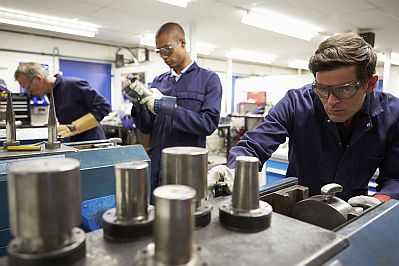What's Trending in 2023 (and what to do about it)
John Abplanalp, the founder of Tight Lines Advisors, has spent more than 35 years in manufacturing. Now, his company helps clients implement sustainable process changes, drive greater productivity, and expand capabilities, all while reducing their costs. As we look to 2023, Abplanalp writes what he sees on the horizon and what he expects to be trending in the new year.
First, the obvious. High inflation is not transitory. That trend is projected to continue at an elevated level for at least the first half of 2023 and according to several economists, may not abate until the following year. Disconcerting to say the least. Under the guise of these market conditions, the trend for onshoring continues as an effort to offset a variety of global headwinds. The shift from lower to higher labor costs, supply chain issues, material costs, and omnipresent inflation can be daunting.

Markets are expected to remain volatile with industry experts projecting them to reflect the inflation trajectory. The economy is performing wildly different across sectors and geographies. To companies seeking growth and sustainable profitability during these uncertain times the way out is greater productivity throughout the entire organization.
And then there's "traditional wisdom," which many have subscribed to in the past (a lot still do) that reads something like this: When the economy is running on all cylinders, that is the ideal time to experiment with new offerings for customers in the name of future growth. When the short-term economic future is uncertain, that is when you must dial down the innovation and experimentation and focus instead on "doing what's worked in the past" and cutting costs whenever and wherever possible.
The key word here is "traditional." Not "wisdom."
This way of increasing productivity is part of a "back-in-the-day" mindset. It's a way of running a business that is as outdated as an eight-track tape player.

I would strongly recommend replacing the word "traditional" with "transformative."
The future will welcome nimble companies that revitalize their operations to meet the goals of its various stakeholder groups.
It is a future where the entire organization is evaluated, and appropriate changes are applied to its operational structure in a timely manner -- where changes to facility layout, design, training, and marketing are implemented to capitalize on the company's performance as it improves. The purpose-driven company of tomorrow will progress as all departments continue to experience improvement through constant advancements in digital technology that result in greater efficiency.
"Digital" and all that it implies in relation to productivity in general and manufacturing is no longer to be considered as a trend. Rather, its ubiquitous acceptance is being experienced in every facet of business. Yet within the digital realm, technologies continue to emerge that spawn trends ("sub-trends" is a name some digital devotees have suggested) on their own and for good reason.

These technologies and ways of working help eliminate inefficiencies and wasted time in manufacturing and production processes -- which inherently trims costs. Also, they provide the knowledge and data required to create next-gen offerings for customers, driving greater sales and top-line growth.
Professional training and education continue to trend. Many people-centric businesses offer continuous learning and personal development opportunities. Unfortunately, as a result of the pandemic, some were necessarily interrupted, but that is in the rear-view mirror.
That trend will need to accelerate to meet the skills needs in the years ahead. According to a recent study conducted by Deloitte, only 50% of production employees feel ready to take on advanced roles, and 60% of skills shortages are due to insufficient STEM education and vocational training. Employee expectations -- especially among younger generations -- are changing. The trend: Nearly 40% of new manufacturing talent have different career and job expectations than previous generations.

Tempering the various digital technology trends underway comes the revelations contained in a recent study by Enno Siemsen, a professor of operations and information management at the Wisconsin School of Business that offers a cautionary tale of the impact of the digital universe and its effects on productivity. It grew in part out of observing how technology was changing standardization and the nature of work.
A German manufacturing company was the setting for the study. At the plant, workers were using augmented reality (AR) smart glasses but were also still using paper instructions to complete production tasks. Employees were divided into two groups of twenty-five. One group was given smart glasses that directed each step for the wearer while the other group used paper instructions to assemble an actual standardized product for the first time.
The study states that "The AR group used 43.8 percent less time than the paper group on the first product assembly. During the second product assembly, both groups had to work without smart glasses or paper instructions, respectively. In this case, the results flipped: The AR group needed 23 percent more time than the paper control group. Not only did the paper group work faster the second time through, but they had a greater degree of innovation and process improvement. When asked to provide ideas for improving the assembly process, only workers from the paper group submitted meaningful improvement recommendations."

Although the long-term significance is unclear, Professor Siemsen says, taking a hybrid approach to AR implementation might overcome some of what the study suggests are drawbacks. Much is yet to be done in determining the effects of technology on productivity but what this study underscores are the need to tread cautiously before jumping headlong into the emerging digitization of processes as a panacea for improving productivity. Especially at the risk of impacting overall workforce efficiency and their contributions.
Siemsen concludes that, "Technology doesn't replace human beings; it's supposed to make them better. In this case, it clearly makes them better, but depending on how you use it, it might not bring out their best."
My take is to start smartly. Do not make CapEx (either tech or equipment) your default solution initially. Instead, understand, improve, and refine your existing process to get the most out of them. Then, with discretion and restraint, spend as needed and where appropriate.
By all counts, a roller coaster year is anticipated. While many challenges remain and more will inevitably emerge, it is also a time to take advantage of opportunities when and where they appear. To capitalize, leaders must keep one eye on tomorrow and the other squarely on reimagining their organization to be well prepared.
As the new year approaches, I'm talking with business executives about how to generate value creation and sustainable profitability in 2023 and beyond. Our talks are lively and energetic, sometimes opinionated, but always valuable for the insights and ideas they reveal. If you would like talk about the trends you have read about and how they can affect your productivity, I invite you contact me.
Want more information? Click below.
Email John Ablanalp: johnabplanalp@tightlinesadvisors.com
Rate this article
View our terms of use and privacy policy ::m::